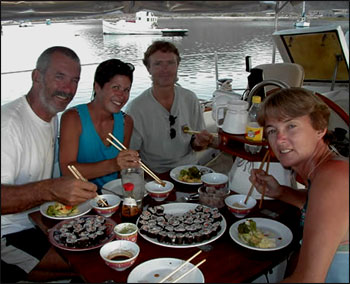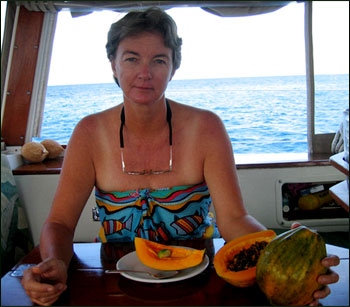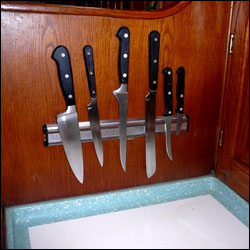We eat well and interestingly most all the time. Never waste calories on something we don't like! Usually have full meals, a holdover from charter days…a habit I am trying to trim back. We try to eat healthfully, but subscribe to everything in moderation…including moderation. No matter what, always lots of veggies and fruit when available. Thanks to the freezer I can always have some frozen veggie on hand.
 |
Sushi party |
 |
Gwen and papaya |
We eat 99.9% of our meals in the cockpit, enabled by a ingenious cockpit table and an enclosure for foul weather. Make sure you have a really good, usable cockpit table!!!
We start each day with a long leisurely coffee together (this is “board meeting” time), then breakfast (currently fruit, yogurt and muesli or toast and peanut butter), salads or
sandwiches (or fish tacos in Mexico !!!! ...oh, I miss Mexico !)
for lunch, cocktails or afternoon tea depending on the mood or if we are underway, and a cooked dinner with lots of veggies or soup for dinner. We are incorrigible snackers (actually…we repent all the time, we just don't reform!)
Major culprits cookies and peanuts or a gorp-like mix of nuts and dried fruit. We keep a hammock with snacks.
For passages, I usually precook and freeze things that can be easily reheated – usually warming and gooey comfort foods like enchiladas, meatloaf, chili, lasagna, ratatouille. We've been known to put on weight on passage!
We use Galleyware white plastic plates and bowls (big and small) with non-skid rings on bottom. These look like nice china but won't slip when underway or break if dropped. We use bowls instead of plates underway. We prefer china coffee mugs and good quality stainless flatware, but make do with plastic wine glasses (just couldn't find a good place to stow glass safely). We love our tall Tervis insulated tumblers for cocktails and water. We are BIG water drinkers and keep 3 liters of water in the fridge at all times.
We use cloth napkins, (or paper towels for messy stuff),
but don't bother with place mats or a table cloth. (I always admire those cruisers at potlucks who have all that stuff.) We also have a small insulated ice bucket, since we can freeze ice trays in our Minus 40 freezer; this makes us very popular at potlucks.
Dishwashing : the rule on our boat, as it was during our charter days: whoever cooks doesn't do dishes, with the proviso that the cook cleans as she/he goes along and doesn't leave it all!
The exception to this rule (since I do most of the cooking these days except for coffee) is, if Don is into a major maintenance project, I will usually cook AND wash up.
|
